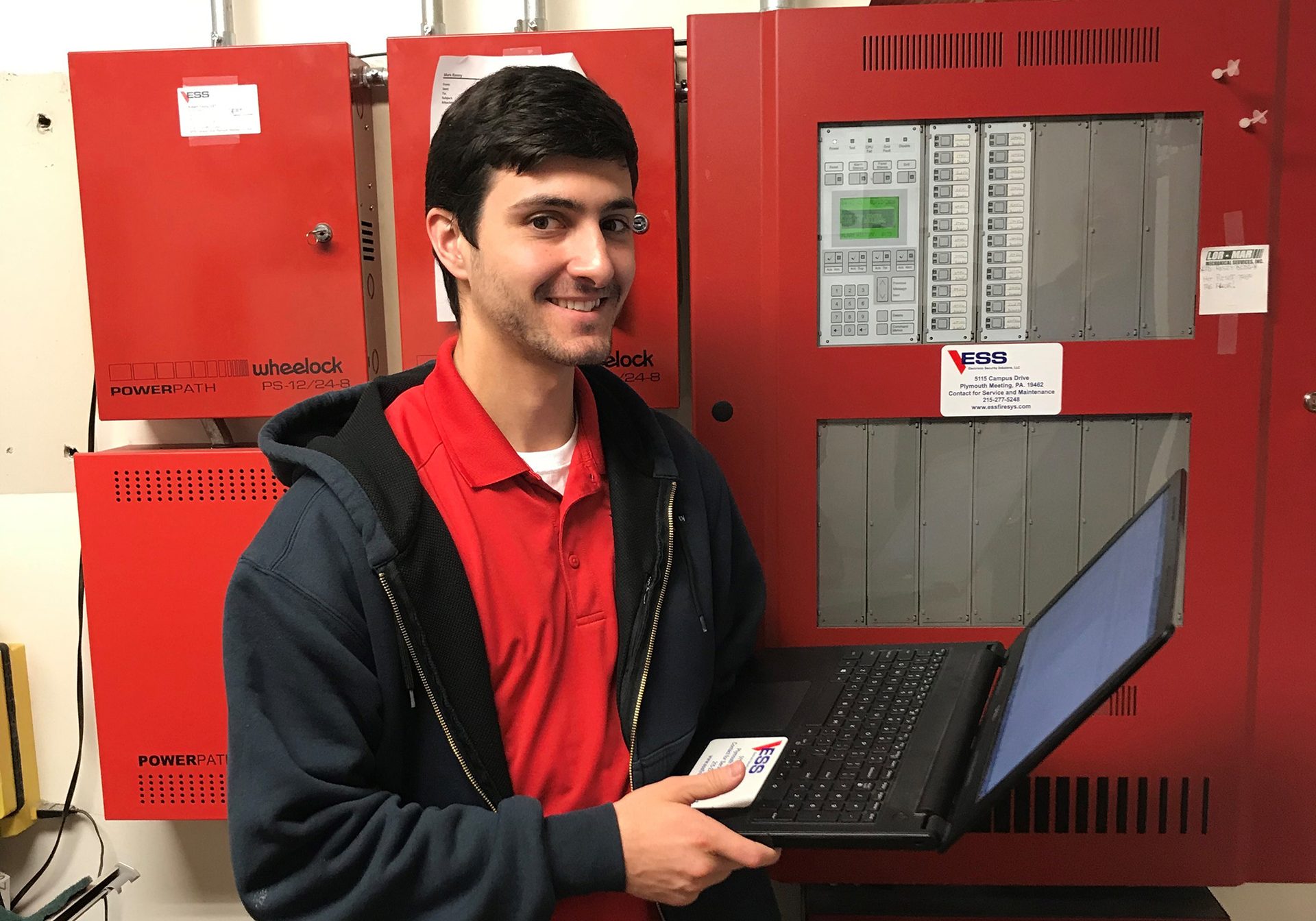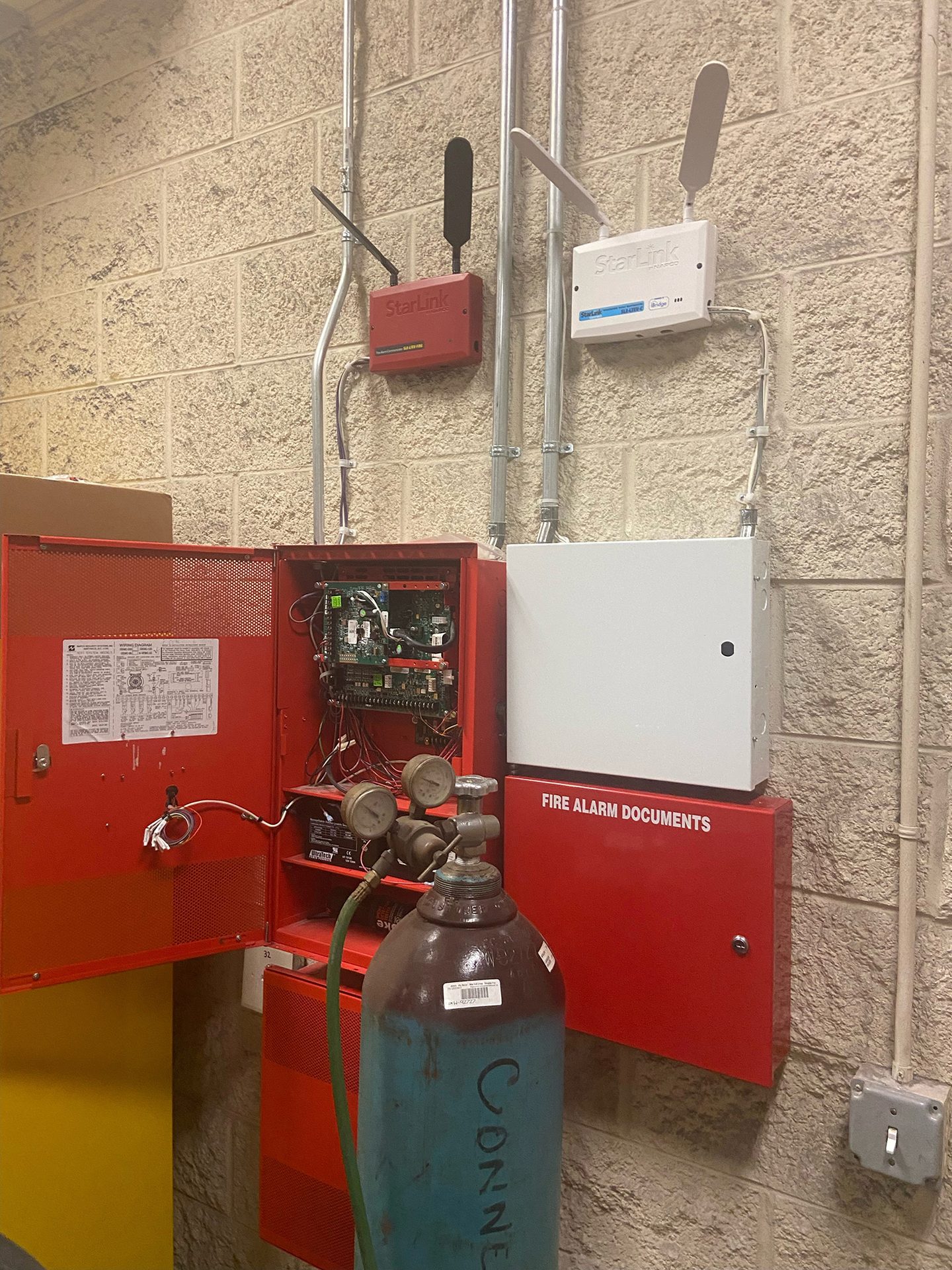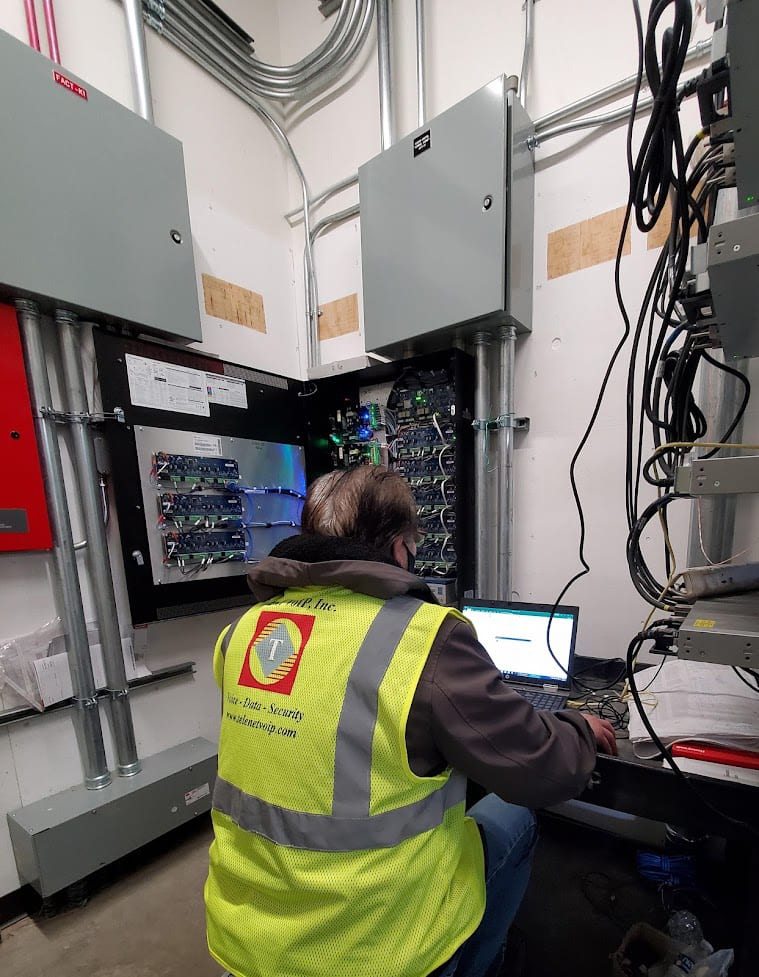SDM exclusive

State Market
of the
Fire Alarms

State Market
of the
Fire Alarms

A technician for Electronic Security Solutions (ESS), a Sciens Building Solutions company, pictured with a fire alarm control installation in the Philadelphia area.
IMAGE COURTESY OF SCIENS BUILDING SOLUTIONS
Although the industry remains subject to supply chain disruption, a precarious labor shortage and other headwinds, multiple growth factors are creating a lot of overall positivity across the fire alarm systems marketplace.
By Rodney Bosch, SDM Senior Editor
If you are looking for the most succinct description of how industry professionals view the current state of the fire/life safety market, “cautiously optimistic” would be an accurate characterization. If not for a few real-world concerns — supply chain woes, labor shortages and looming recessionary headwinds — the prevailing sentiment would be considerably rosier.
According to SDM’s 2022 Industry Forecast, 40 percent of security professionals consider the state of the fire alarm market to be very good or excellent, while 46 percent consider it to be good, and 14 percent believe the state of the market is poor or fair. The forecast also found the number of contractors that currently offer/sell/install fire alarm products and services stands at 59 percent, a 12 percentage point jump in 2022 compared to the previous year. Of those not currently offering fire alarm products and services, 19 percent have plans to start offering them within five years.
Ahead, we explore factors that are driving — and hindering — growth in the fire alarm market, along with the latest in codes, supply chain ramifications and more with several industry professionals from the integration and manufacturing communities.
Current State of the Market
SDM asked, “How would you rate the current state of the market for fire alarm/emergency communications?”
Perception of the state of the fire alarm market showed marked improvement across the board in 2021 compared to 2020.
// Source: SDM 2021 and 2022 Industry Forecast Studies
2022: Recovery & Rising Prospects
Sources interviewed for this report entered 2021 still contending with lingering aftershocks from the COVID-19 shutdown the prior year. And yet the market’s resiliency — fueled in part by the code-driven necessity for fire alarms and life safety systems and services — proved to be durable across a range of customers with specialized needs. The ongoing communications transition brought on by 3G sunsets and the demise of plain old telephone service (POTS) lines has also helped buttress the industry during the worst of the economic calamity.
“I really expect growth to continue because of the current backlog of work, and the continued strong demand that my customers are telling me about,” says Duane Warehime, vice president sales, Southern region, NAPCO Security Technologies, Amityville, N.Y. “Everybody is complaining they can’t get enough people [due to the labor shortage]. But everybody’s busy. Everybody has work booked several months out. I think that’s going to continue for a while now.”
88
%
The percentage of security professionals who consider the state of the fire alarm market to be excellent, very good or good.
// Source: SDM 2022 Industry Forecast
Still to play out in the months ahead are the Federal Reserve’s plans to keep increasing interest rates until inflation is under control. Will the Fed’s strategic course cause a recession? Time will tell. But even a negative perception of the general economy could have consequences for the fire alarm market, Warehime suggests.
“What people believe, matters. If the media is telling them that there’s a recession, if they’re hearing it everywhere — even if they don’t see it in their own lives — they believe a slowdown is coming,” Warehime adds. “They are going to adjust their behavior and potentially delay purchases, like fire alarm upgrades or new construction projects.”
With so many market variables to track it will be incumbent for all businesses — integrators and manufacturers alike — to be constantly forecasting and modifying processes, says Jonathan Keener, marketing manager, Hochiki America Corp., Buena Park, Calif.
“Hochiki’s growth has improved substantially this year and we don’t see any signs of that changing,” he says. “We are expecting to finish this year outperforming our projections. Supply chain issues are still challenging, but little by little they are getting better. We surprisingly saw our highest number of trade show visits in 2022 in 19 years. And with momentum building in the construction industry, it seems reasonable that fire alarm product demand will increase as well.”
How Codes Are Driving New Revenue
So what are some of the more recent code compliance factors that are helping fuel the fire alarm systems market? For starters, multiple sources for this report cite emergency responder radio enhancement systems (ERCES) being enforced in more and more jurisdictions nationwide.
“This presents a great opportunity for fire alarm installation and service companies to add profitable installation revenue, as well as generate long-term service revenue from the testing and maintenance that is required of ERCES systems,” says Craig Summers, vice president of sales, fire & safety, Potter Electric Signal Co., St. Louis. “Some of our dealers have really embraced this opportunity and are acting as consultants now to other fire alarm companies that want to add these services.”
Sciens Building Solutions and ACT Security are also actively pursuing this space. “This is critical for commercial building safety, as it helps ensure first responders can effectively communicate from inside buildings to get the tools and resources they need for mitigating potential emergencies before they occur,” Sciens CEO Terry Heath says.
Under this technology type is the bi-directional amplifier (BDA) and distributed antenna system (DAS). A BDA system is a signal boosting solution designed to enhance in-building radio frequency (RF) signal coverage for public safety radio. A public safety DAS is a built-in wireless radio system that supplies radio signals to first responders for communication during emergencies. Many companies are required by the National Fire Protection Association (NFPA) to have these units installed in their buildings.
BDA and DAS codes are becoming more widely accepted as requisite for new high-rise buildings, says ACT Security’s Chuck Robinson, who adds that these systems will continue to drive growth as municipalities begin adopting these code requirements.
Dick Bauer, Notifier by Honeywell Fire, also emphasizes that ERCES remains a key focus area with AHJs. While both UL (UL2524) and NFPA (NFPA 1221) have developed standards for the manufacturing and installation of these systems, wide-scale adoption and enforcement of this technology has not yet been achieved.
“Here is another example of how our industry can positively impact the outcomes for first responders by improving the radio coverage when inside a building,” Bauer says. “It’s important that we also remember that it’s not just firefighters here. EMS, law enforcement and other emergency agencies also need reliable communications within these facilities and these ERCES systems have the same level of integrity as that of a fire alarm system.”
Bauer also explains every three years the various model codes and the installation standards for fire alarm and signaling systems are updated. A handful of states will begin adopting these codes and standards 12 to 18 months after they are published.
“For instance, the 2021 edition of the International Fire Code, International Existing Building Code, NFPA 1 [Fire Code] and NFPA 101 [Life Safety Code] were not published until the Fall of 2022,” he says. “California adopted the 2021 IFC, but it will not have an effective date until Jan. 1, 2023, while Oregon is still in the process of adopting the 2021 IFC. Florida and Massachusetts have also initiated the process to adopt NFPA 1 and NFPA 101.”
Bauer provided other key changes to the model codes that will enhance public life safety:
Group S Occupancies — A new section was added to the IFC that requires public self-storage occupancies that are three stories or greater in height with interior corridors or interior common areas to have a manual pull station that activates the fire alarm occupant notification system. Strobe lights are not required within storage units.
An exception stipulates that a manual fire alarm system is not required when the building is equipped with an automatic sprinkler system that activates the notification appliances after sprinkler water flow switch activation. This new requirement will increase their available safe egress time for occupants in multi-story public self-storage buildings.
520 HZ Low Frequency Audible Alarm Signal (Low Frequency Signal) — New provisions were added to the IFC, NFPA 1 and NFPA 101, which require the audible alarm signal from smoke alarms installed in sleeping rooms of hotels, university dormitories and apartment building bedrooms to be the low frequency signal. This requirement only applies when the code requires these buildings to have a fire alarm system.
The new section stipulates that where a sleeping room smoke alarm is unable to produce a low frequency signal, the low frequency signal shall be provided by a listed notification appliance or a smoke detector with an integral low frequency sounder. This change will enhance the safety of all people sleeping in hotels, dormitories, and apartment buildings, but most importantly high-risk segments of the population such as school-age children, people who are hard of hearing, the elderly and people who are alcohol impaired.
Mass Notification Risk Analysis — When an existing K-12 school is replacing the fire alarm system, a new section to NFPA 101 requires a mass notification risk analysis to be performed to determine if a mass notification system is required. Where a mass notification system is required by the risk analysis, a mass notification system shall be installed in accordance with chapter 24 of NFPA 72. This change will help to protect students and faculty in existing K-12 schools during all types of emergencies and may lead to more mass notification systems being installed.
//
The fire alarm industry, including Honeywell, once again showed resiliency by persevering and adapting through the past couple of tumultuous years, expresses Dick Bauer, vice president of sales, Notifier, Honeywell Fire, Honeywell Building Technologies.
“Unlike many other industries where employees could work remotely, manufacturers and distributors needed to remain on the front lines,” Bauer says. “This pushed us to quickly adapt with new safety protocols and evolve our processes to focus on our customers’ challenges and goals, while keeping the changing landscape in mind. As with anything, the lessons learned in 2020 gave us a clearer path forward in 2021 and beyond.”
Communications Upgrades Drive Growth
George Brody, president of Atlanta-based Telguard, explains that in August 2019, the FCC released an order which in essence marks 2022 as the year in which telephone networks will no longer be required to maintain landlines and will in fact be allowed to deactivate and/or raise prices on existing POTS lines.
“Although the full impact of this is expected to be felt as the year ends and starting in 2023 from a service pricing and availability perspective, landline cutting continues to accelerate in the commercial market, especially with fire systems,” Brody says. “As the cutting continues to accelerate, manufacturers of cellular/internet fire communicators, such as Telguard, stand to benefit. Having the Telguard Commercial Fire Communicators both cellular and dual path units with UL864 and NFPA 72-compliant provides an easy POTS change out, lowers the monthly cost for the building owner, and provides RMR for the fire systems dealers and integrators.”
Daniel Rosales, senior director, technical services, Telguard, highlights the company’s collaboration with Honeywell to provide cellular alarm communicators, integrated with Connected Life Safety Services (CLSS), as an example of how the industry is bringing to market advanced communications and new services.
“CLSS is an innovative, all-in-one cloud solution built on Honeywell Forge, a powerful analytics platform that enables real-time data and visual intelligence for connected buildings,” Rosales explains. “CLSS equips fire systems installers and facilities managers to deliver enhanced fire safety services while maximizing the performance of Honeywell’s trusted detection and notification systems.”
StarLink Universal Cellular Communicators (StarLink Fire Cell Communicator is red, at left top) installed in a city vehicle maintenance building in Michigan by Interstate Security. A NAPCO Firewolf fire alarm control panel is shown open. The system is capable of shutting off gas pumps when in alarm.
IMAGE COURTESY OF NAPCO

Brandon Clig, sales manager for Rochester, Minn.-based Custom Alarm, explains CLSS can help increase fire system connectivity, improve alarm signal reporting detail and optimize the communication path of alarm signals. Rather than having to be onsite to determine the cause of trouble or supervisory signals, CLSS allows end users to review their current system status from an app or web browser. Custom Alarm, which also deploys CLSS with Notifier by Honeywell fire alarm control panels, is leveraging the service to create new recurring revenue.
“We found it to be pretty useful with facility managers,” Clig says. “On a Saturday night when they’re getting a call because of a dirty smoke head, they’re now able to pull it up on their phone and say, ‘OK, I can disregard that when the monitoring center calls, but we’ll address that on Monday. I don’t need to go out there at two o’clock in the morning.’ Just the ability through that app and through IP monitoring, how you can do it through cellular communication is really taking the next step forward. In the next five years phone lines are going to be completely gone.”
Communications upgrades of existing systems will continue to be a driver for new business for years to come, says NAPCO’s Warehime. “In many ways, we’ve benefited from the fact that a lot of alarm dealers have noticed this opportunity and really jumped on it. But there’s still a lot of opportunity out there,” he says. “And there are still a lot of people who don’t see it as big as we do.”
Fighting Through Supply Chain Disorder
When taking a wide view of the security and fire/life safety industry, supply chain disruption has seemed to disproportionally fall on the fire alarm sector, says Mark Hillenburg, vice president of industry relations, DMP, Springfield, Mo. The company has been able to maintain a steady supply of fire alarm control panels manufactured at its factory, which Hillenburg credits to an ownership structure that allows the company to invest millions of dollars over and above traditional levels to maintain inventory.
“What has been a challenge is the fact that we are not a sensor manufacturer, so we lean on OEM partners for our sensors, and they have had a difficult time maintaining availability of certain popular sensors,” Hillenburg says. “The shortage has started to alleviate itself in the past month or so. We hope for a steadier supply in the market going forward.”
Even a fire alarm system that is deficit just one component can prevent the entire system from being brought online, and that can hold up the occupancy of the premises, Hillenburg continues. “That can become a costly issue. One that has had fire alarm dealers scurrying around the internet to find that one last piece of the puzzle to complete this install.”
Custom Alarm CEO Melissa Brinkman knows all too well of this particular predicament. The issue has caused huge frustration with end users and from general contractors.
“It’s happened with new construction and just in general,” she says. “Customers can’t get occupancy because we can’t get installs done because we can’t get parts, so it creates this cascading effect that is really impactful. It’s not the same, for example, with cameras. If we are short on cameras someone can still occupy the building. But with life safety and fire alarm systems, it disrupts the business and causes delays.”
Who knows what growth rate the fire alarm market could have achieved if not for the supply chain chaos, Duane Warehime of NAPCO ponders. “I even heard from a dealer not too long ago that one of their customers was so far in the hole on systems that had not been finished, they weren’t doing any new jobs because they couldn’t finish the ones they had,” he says. “They need to get paid for those before they could move forward.”
ACT Security’s Chuck Robinson saw multiple opportunities in the marketplace go by the wayside because the broken supply chain drastically impacted its ability to take them on. “Those that were ahead the JIT [just-in-time] inventory change and had stock would have performed dramatically better than those that were reliant upon manufacturer delivery schedules,” he says.
Telenet VoIP is not alone in having experienced equipment on back order for as long as an entire year. “We have had to work closely with the customers, engineers and designers to find solutions that would allow us to complete projects without sacrificing safety and quality of work,” Nick Payab says. “Furthermore, the manufacturers have had to raise prices on equipment. Some have raised prices four times and as much as 50 percent in a span of one year.”
That has been especially painful for Telenet VoIP since its projects are based on hard bid contracts, meaning the company is not able to pass cost increases along to its end customers, which has resulted in zero profitability on some of its projects. “The price increases force us to put higher prices on the new projects,” Payab explains. “Some of these projects were not estimated by the owners for higher costs and have been shelved or have gone out for re-bid several times in the hopes of getting lower bids.”
//
Warehime explains a big piece of the puzzle that a lot of people are missing is the dialer capture component — the ability to essentially connect to what used to be the phone jacks to the alarm panel.
“We can do that through the cellular radio, then forward the communications to the customer’s central station, in some cases completely ignoring the information that’s programmed into the alarm control,” he says.
Warehime illustrates this opportunity by explaining a fictional scenario: A large end user has 30 branches spread across six states. Over the years their facilities have been serviced by multiple companies using different fire alarm control panels.
“If you’re a large national account or one of these consolidating dealer companies, you can have the ability to service that entire market. You can walk in and put NAPCO radios on all the fire alarm panels and they can now deal with one company,” he continues. “That is a huge change in the marketplace. They can just walk in and take over customers without having to reinstall a whole new fire alarm system with all the additional components that are required, etc., for compatibility.”
Revenue Change Expectations
SDM asked in 2021, “Compared to this year, how do you expect your company’s revenue in each of the following categories to change next year?”
The percent of respondents that anticipated fire alarm/emergency communications revenue would grow in 2022 ticked up 5 percentage points over predictions from the previous year. More than 1 in 2 respondents expected status quo performance.
// Source: SDM 2021 and 2022 Industry Forecast Studies
Hot Vertical Markets
For Nashville-based ACT Security’s fire alarm business, top line sales have continued to rise in 2022, with revenue up versus the prior year as manufacturers are now starting to deliver equipment, says Chuck Robinson, director of sales for the integrator’s commercial and government division.
“We are really focusing in on our contractor relationships and the multi-tenant improvement market. Our project size is smaller than previous years, but our volume is substantially higher,” Robinson says. “We are also focused on after-the-install services such as monitoring, annual inspections and service agreements. Our inspection portfolio has grown substantially in the last three years and continues to be an area of focus for our company.”
The resizing of office space is driving tenant improvement work, Robinson explains. Many office spaces are being reduced in size and new tenants are being brought in. What used to be a single office space is now being converted into two to three individual work places.
Robinson says as companies continue to evaluate their office needs, the tenant improvement market will continue to trend upward as companies allow leases to expire or renegotiate or sublet their spaces. “It will be interesting to see how sustainable or long-term it is as we watch the economy and construction markets, heading into what many believe could be a recession,” he adds.
$84
BILLION
The amount the global fire protection system market is expected to surpass by 2026.
// Source: MarketsandMarkets Fire Protection Systems Report
Pleasanton, Calif.-based Sciens Building Solutions, a security and life safety integrator with a growing national footprint thanks to an aggressive M&A strategy, is also experiencing growth in office space and multi-tenant facilities, says CEO Terry Heath. The rising trend in this particular market niche has resulted from the movement of many companies into new areas, mainly during and after the COVID-19 pandemic.
“This can lead to temporary building vacancy in the cities they are moving from,” Heath says, “but also creates new opportunity for us: In the new cities and buildings they are moving into, as well as new companies moving into those vacated spaces, which potentially adds to our customer portfolio across the country. … We’re excited for the future because, as we grow, we can offer even more collaborative efforts to our valued clients. This can make their work more convenient by having one life safety provider across all their projects.”
With a rising population in and around its home base of Rochester, Minn., Custom Alarm is also increasingly finding the multi-tenant housing market a rich vein of new revenue through new construction and monitoring services. Providing fire alarms for houses of worship, based on occupancy classification, is another vertical the company is finding success with in 2022.
Adding Fire Services
SDM asked, “Are you offering, or planning on offering, fire alarm products and services?”
The number of contractors that currently offer/sell/install fire alarm products and services jumped 12 percentage points in 2022 compared to the previous year. Of those not currently offering fire alarm products and services, 19 percent have plans to start offering them within five years.
// Source: SDM 2022 Industry Forecast Study
“Within the fire alarm industry there are a lot of different integrations that we can do with the lock downs and stuff like that,” Clig says. “That’s the key factor that has helped drive some of those sales. With life safety systems you can integrate different lockdown situations or building notifications within that fire alarm system. So it’s getting a little bit different than in years past with fire alarms. You once had a fire in the building and you wanted to get the notification out so everybody gets up out of the building. But now it’s more of like, 'OK, how can I also use this with different applications?'”
Telenet VoIP, an integrator, has been servicing the Southern California region for two decades, primarily in the education market, including K-12, community colleges and universities. Much like other sectors, there are ebbs and flows in the type, size and number of fire alarm projects that come to bid each year. This is very much tied in with the budgets and bonds school districts have for major modernization and renovation of the schools, explains Vice President Nick Payab.
A commercial fire system installation utilizing the TG-7FS Communicator by Telguard.
IMAGE COURTESY OF TELGUARD

The company’s project timelines are mostly between six months to three years, and based on the projects won in 2021 and prior, Telenet VoIP does not anticipate a large increase or decrease in fire alarm work for 2022. However, Payab says there are multiple factors that will contribute to potential growth going forward.
“New requirements in CO detection for schools will bring about larger fire alarm system designs,” he says. “Older systems are being upgraded for voice evacuation requirements. Overall, new NFPA guidelines create large growth potential on the fire alarm system marketplace.”
Further Understanding of the Fire Alarm Market
Subject matter experts interviewed for this story provide additional insights on a range of fire market opportunities, challenges and related topics.
Wireless
There are going to be new wireless fire alarm technologies coming out. There are companies working on them that I believe will emerge with better field results. A lot of what’s been out there for the last few years has not been overwhelmingly wonderful. The dealer base hasn't really loved it. There have been some technical issues in the field. UL has made it harder because of some of the requirements that they put in for sensitivity to interference and things like that. But I think you’re going to see some improvements in wireless technology, which could significantly change the fire alarm business, because that's pretty much exclusively a hardware marketplace. — Duane Warehime, NAPCO
Self-testing Smoke Detectors
Solutions like self-testing smoke detectors will be disruptive to the fire market. These products reduce the number of technicians needed on site and can cut the test and inspection process significantly. Better yet, because technicians can execute inspections from outside the room, self-testing smoke detectors save facility managers and occupants the hassle of unwanted interruptions. And because these detectors can be anywhere from above a conference table to a hotel room to a patient’s room in the ER, curbing disruptions is crucial. Lastly, self-testing smoke detectors also provide additional safety because the system curbs any human error: with an automated process, you receive a tracked report that clearly delineates each and every detector was tested. These kinds of technologies have the potential to revolutionize the way fire and life safety systems are installed, tested and maintained, and will move the needle for the industry as a whole. — Dick Bauer, Notifier by Honeywell
Staffing/Training
We are making sure that we’re keeping our team well trained and supporting them and making sure they are able to do the best job they can so that they want to remain working here. We do a nice job of keeping people engaged and [retaining] long-time employees. We continue to recruit more people to add to our team. Because the sales team continues to find new opportunities, we need the install team to continue to find ways to install it. We are finding more [fire alarm system] opportunities and selling more. And so we need to make sure that we keep finding the right people to help do quality installs. — Melissa Brinkman, Custom Alarm
Market Threats
The biggest threat facing our industry is the supply chain and inflation in the cost of labor and material. As the federal government is working to slow down the economy to lower the inflation, we anticipate that equipment price hikes and supply chain issues will subside; however, we hope that the correction is not excessive to bring about a full recession. — Nick Payab, Telenet VoIP
Sole Path
Acceleration of sole path cellular communications adoption can be seen across the country with AHJs. We are seeing continued momentum with sole path cellular communications being the first-choice communication path with dealers/integrators. — George Brody, Teleguard
//
The phasing out of POTS lines and the sunsetting of older generation cellular services continues to disrupt school districts and other educational institutions across the nation, while providing new, long-term opportunities for security and life safety integrators.
“Due to the POTS issue, Telenet VoIP has implemented an AES mesh radio service so that we can eliminate both the use of POTS lines and the cellular dialers, and provide a proven technology that has been in use for several decades,” Payab says. “AES has been very supportive and helpful in assisting us to build the system. We are in the early stages of putting new accounts on the platform and looking at building a solid solution for all our fire alarm customers.”
In the emerging markets arena, Keener of Hochiki identifies facilities in the renewable energy sector as currently experiencing significant growth, which he expects to continue well into the future. “Wind, solar and battery energy storage systems [BESS] are good opportunities for many reasons,” he advises. “Many of these systems can benefit from fire protection. I think that will be enforced more and more in energy storage systems with NFPA 855 and UL 9540A providing a standard for all AHJs to follow for compliance of BESS installations.”
Telenet VoIP, an integrator serving the Southern California region, has experienced equipment back orders for as long as an entire year due to supply chain disarray.
IMAGE COURTESY OF TELENET VOIP

No doubt sharing the sentiment of most all his industry brethren, Keener is looking forward to the return to where everyone was at the end of 2019, before the pandemic irrevocably impacted the entire world. Getting whole again and on solid footing for the future will be no easy trek, he expresses.
“Rising costs due to inflation will drive up the cost of fire alarm products. Labor shortages can impact schedules and workflow,” Keener postulates. “Competition among product manufacturers can impact the sales — and success — of any business. But regardless of the threats, fire alarm and life safety systems serve a valuable purpose. The industry must work hard and overcome all challenges so that this vital and potentially life-saving equipment can continue to be provided, installed, and maintained. Lives depend on it.” SDM
38
%
The percentage of security professionals expecting an increase in revenue from fire alarm products and services in the next year.

